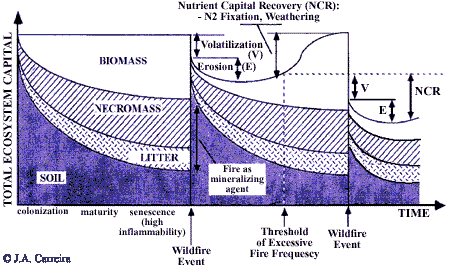
Conceptual model of wildfire cycle in response to increasing fire
frequency, in a semiarid Mediterranean shrubland ecosystem:
Following a fire event, inflammability gradually increases as biomass,
dead plant mass and litter accumulate; eventually, a senescence stage
is reached when a new wildfire is likely to occur. Fire-related ash
deposition and mineralization result in high nutrient availability
in the soil, facilitating rapid recovery of vegetation and increase
in inflammability, eventually resulting in another fire event and
re-initiation of the cycle. However, if fire frequency is abnormally
high the ecosystem nutrient capital does not fully recover, finally
leading to long-term soil fertility depletion, slower post-fire vegetation
recovery, increased erosion, and desertification.
|
![]() No. 54, November/December 2003
No. 54, November/December 2003